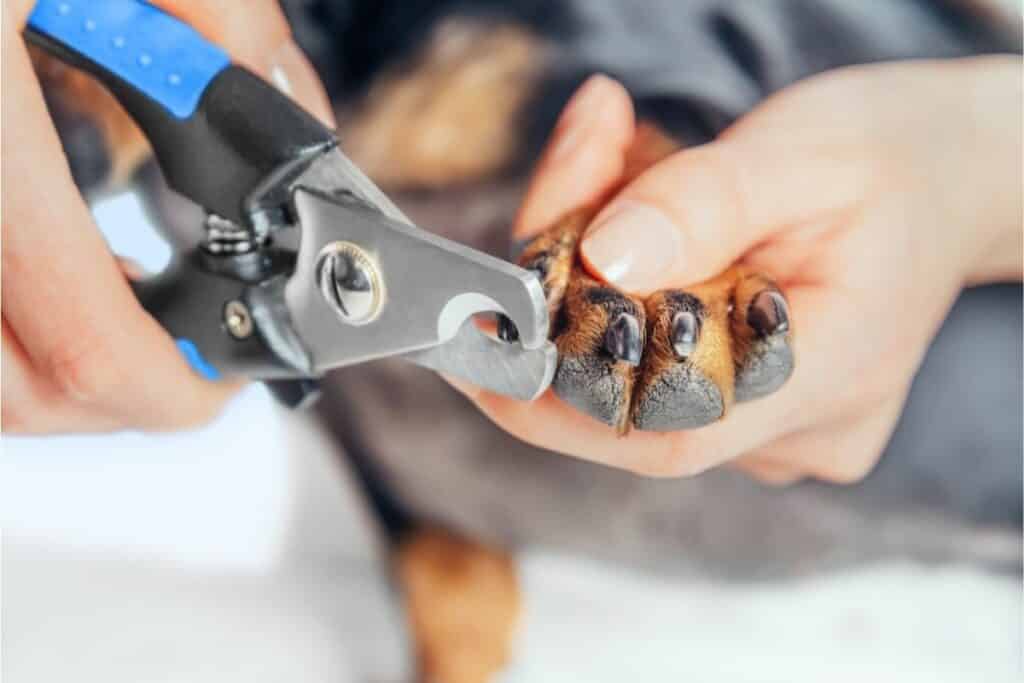Dogs may be cute, but if you’ve ever been scratched by your pup, you’ll know how their nails can be a hindrance. Dogs can be restless when they’re being groomed, but it isn’t always possible to take them to a professional groomer.
It’s important to do this in the right way to avoid harming your pup. If you’re wondering how to trim your dog’s nails, keep reading.

We’ll cover how to do this in this article, as well as why it’s so important for your dog to be groomed regularly.
Why Is It Important To Trim A Dog’s Overgrown Nails?
If a dog’s nails get too long, this can be uncomfortable and may lead to health concerns. If the nails keep tapping on the floor, the dog’s toes can spread out, adding extra pressure on the feet and legs.
Overgrown dog nails can cause tendon injuries and misshapen feet later. If your dog is lucky enough to avoid these issues, long nails can cause discomfort for your dog.
Please note, NEVER think you can just cut your dog’s nails the way you would with human nails. Dog’s nails are different as they have blood vessels and nerves at the center.
This is known as the ‘quick’. Dogs that have longer nails will have a bigger quick, which makes it harder to trim the nail correctly.
If your dog does have longer nails, don’t panic! You can trim long dog nails by trimming slowly, taking off a little bit at a time. Gradual trimming will help the quick retreat to a smaller length.
Start by trimming off the tip of the nail, then trim a little bit more once each week. Regular grooming will reduce the quick, which can make it easier to keep your pup’s nails at a reasonable length.
How To Trim A Dog’s Nails
Follow these steps when trimming your dog’s nails.
Step 1: Put Your Dog At Ease
If your pup doesn’t like having their nails groomed, you can try to ease their fear of the trimming tools. Keep in mind that this counts as training, so it may take some time.
Place the nail clippers down and allow your dog to sniff them. Reward them with a treat any time they explore the clippers. Keep doing this process and wait for your dog to be happy around the nail tools. We’re trying to make the dog view the clippers with positivity instead of fear.
The same method applies if you’re thinking about using a rotary nail grinder on your dog’s nails. These devices can generate a lot of sounds, so try to grow your pup’s confidence around the noise. This involves the same tactic, rewarding the dog with a treat once you turn the grinder on.
Always be patient with your dog. Some dogs can learn slower than others, particularly if they’ve previously had an injury from nail tools. Keep the training up, and they should relax eventually.
Step 2: Place Your Dog’s Paw In The Right Position
You’ll have an easier time trimming your dog’s nails if they are relaxed. If you can, have another person there to pet and distract the dog. You can hold smaller dogs in your lap to keep them relaxed, but make sure you can still see the nails well to avoid injury.
Make sure you’re in a safe position and have good visibility. Lift the dog’s paw and keep it held near their body. This will stop them from pulling their paw away and interrupting the process.
If you need to single out a nail, lightly squeeze their paw and gently raise one of their toes. This can help you focus on each nail.
Step 3: Find The Quick
Don’t begin cutting your dog’s nails unless you’ve found the quick. You can do this by looking at their nails in good light. It’s easier to find the quick on light-colored nails, as it will look like a darker pink part inside the nail.
It’s much harder to find the quick on dogs with darker nails. If this is the case, only trim little bits of the nail each time. Look at the nail’s tip after each tiny cut. As you cut further down the nail, you’ll notice a pink-gray circle form on top of the cut area.
If you see a little black dot in the middle of the white area, stop cutting, as this indicates that you’re near the quick.
Step 4: Trim The Nails Efficiently
After you’ve sat in the right position, selected a nail, and found the quick, you can begin cutting the nails. Use your clippers to trim a tiny bit of nail each time. Look at the natural shape of the nail and cut at the same angle, keeping its usual shape.
Always look at the tip of the nail after each cut, keeping an eye out for the black dot. Try to relax while you cut your dog’s nails, as being stressed may make them restless. Trim the nails quickly, but safely, making sure you don’t take off too much.
You should trim efficiently, but never rush the process, as mishaps may occur this way. If you need to, take a break. It’s always better to spend more time on the process than to speed through it.
Remember to keep giving your dog affection, treats, and praise so they keep associating nail trimming with positivity.
Step 5: Consistency
It’s important to groom your dog’s nails regularly to avoid health issues later on. Simply repeat the steps above each time you cut their nails.
If your dog’s nails are particularly long or if you’ve just started trimming them, you probably won’t cut all of them at once. You may need to wait a few minutes, hours, or even a day to cut each of your dog’s nails.
If your dog is particularly restless, you may have better luck trimming one nail at a time. This also has an advantage, as the dog will become used to the trimming process.
Trimming will have to occur gradually on dogs with very long nails. As long as you keep grooming regularly, the quick will shorten, which will help you figure out how much you should trim.
It’s best to trim your dog’s nails once a week. Keep touching your dog’s paws regularly so they don’t associate you handling them with fear. With consistency, nail trimming will become a regular part of your pup’s routine.
Tips On Trimming Your Dog’s Nails

The steps above should explain how to trim your dog’s nails well, but here are some tips that can make the process easier.
Choose The Right Tools
Unlike humans, dogs will need specialized nail cutters. Compared to our thin and flat nails, dog nails are thicker and rounded. You’ll need to purchase nail clippers that are designed for dogs.
There are many dog nail clippers available. These include scissor nail clippers for shorter nails, guillotine devices that are better for beginners, and clamp clippers that are often used by professionals.
Make sure that you can handle the option you purchase easily. Trying to use a complicated device may injure your pup if you’re not careful.
Ideal Length Of Dog’s Nails
The best length of a dog’s nails will depend on the breed, size, and weight of the dog. In most cases, it’s best to avoid their claws growing past their pads. If they are standing in a usual position, their nails shouldn’t tap on the ground or touch the floor.
Cutting Vs Grinding Dog Nails
Both cutting and grinding are good nail trimming methods, but the one you choose will depend on you and your dog’s preferences.
Some people prefer grinding tools as they make it easier for the user to notice the quick. Despite this, grinding removes less of the nail than clippers do. This means that you’ll have to trim dog nails more regularly than if you used clippers.
Clippers are the traditional tool for trimming nails, but some feel uneasy about trimming too much of their dog’s nails and catching the quick. If you do want to use clippers, make sure you only trim in tiny amounts. This will stop you from catching the quick.
Always look at the nail after each cut and stop trimming if you see a small white dot.
If You Cut The Quick
Cutting the quick will hurt your dog, but it isn’t a huge issue. This can occur if your dog has overgrown long nails, so try not to beat yourself up about it.
If you do cut the quick, use styptic powder to stop the bleeding. If you don’t have this on hand, you can use cornstarch powder as a substitute. Apply a bandage on their paw, but remove this once the bleeding stops.
If you notice a lot of blood or a heavy flow, see your vet immediately.
Keep giving your dog lots of attention and praise. Reward them with treats when they are calm. Afterward, take a break or stop the trimming process completely. Cutting the quick can be a distressing ordeal, so you and your dog need to relax and get better.
Dogs can die when the quick is cut, but this is very rare, especially if your dog is healthy. If you cut your dog’s nail accidentally, the blood may intensify the situation, but it isn’t the end of the world.
A dog’s quick will start bleeding after it’s cut, but it won’t normally bleed for more than a few minutes. The bleeding should start to slow down as the dog’s system begins the healing process.
Despite this, any old or sickly dogs should be treated with more care. If you cut the quick of an impaired dog, take them to the vet as soon as possible. These dogs may be unable to start the healing process and slow down blood flow.
Conclusion
It’s important to keep your dog’s nails at a reasonable length to avoid discomfort and health issues later. However, you shouldn’t trim your pup’s nails as you would with humans, as they have blood vessels at the center of their nails, known as the quick.
Their claws are also thicker and rounded, so they’ll need to be trimmed in a particular manner.
Only trim a tiny amount of your dog’s nails each time, and examine the nail after each cut. If you notice a white spot, stop cutting, as this indicates you’re near the quick.
If you do manage to cut the quick, don’t panic. Stop the bleeding, apply a bandage, and give your dog lots of praise. It can be harder to spot the quick on overgrown nails, so make sure you groom your pup regularly.
Remember, if you feel unconfident grooming your dog’s nails yourself, there’s no shame in going to the groomers for regular maintenance. The most important thing is that your dog is healthy and comfortable.
- What Dog Breeds Have Pink Skin? - March 24, 2023
- What Are the Most Inspiring Dog Breeding Quotes? - March 20, 2023
- Can Pheromone Spray Help Improve Dog Breeding Results? - March 19, 2023








